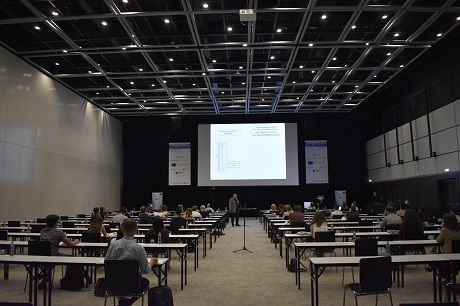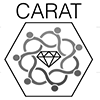World experts discussed how to change the properties of particles atom by atom in Prague
Greener car fuels and a slowdown of the global warming. These are some goals their achievement can be contributed by the findings discussed at the Cluster Meeting 2021. It was organized by the J. Heyrovsky Institute of Physical Chemistry of the CAS. The top international scientists in the field of nanocatalysis accepted the invitation and gathered in Prague.
Let's imagine bunches of grapes with a diverse number of fruits. Some bunches have two grapes, others might have ten or twenty grapes. They are of different shapes and compositions. In this way, we can describe the atom clusters. The clusters are studied in various fields of nanoscience and they are used for example in chemistry to several purposes. The size of these ultrasmall particles is usually millionths of a millimeter, or even smaller.
The Cluster Meeting 2021 took place from 18 to 23 July in Prague. Even the conference itself was a cluster in macro scale. It aimed to bring together the various scientific disciplines directly involved or potentially related to the field of nanocatalysis, the latter to expand the current study of clusters, including the design of new nanomaterials.

The main organizer of the event Stefan Vajda. Photo: Jana Platichova, Centre of Administration and Operations of the CAS
Speakers from thirteen countries, e.g. the United States, Japan, Germany, France, Italy and Austria, spoke at the meeting. There were ninety-four participants at the conference, from fourteen countries and three continents.
Stefan Vajda was the main organizer of the event. He is currently the head of the Department of Nanocatalysis and holds the ERA Chair position the J. Heyrovsky Institute of Physical Chemistry of the CAS. He said "The aim of the meeting was to attract world leaders in the field and create new contacts with Czech scientists". Presenting scientists from the J. Heyrovsky Institute had above-average opportunity to promote their results at the conference. Furthermore, about forty percent of the participants came from Bohemia and Moravia.
The transformation of the carbon dioxide
The main topic of the conference was nanocatalysis, which exploits atomic clusters. Thanks to nanocatalysis, various chemical reactions can be accelerated. Miniature clusters are still little explored. The conference participants discussed experimental insights into the nanocatalysis by clusters, their characterization at the atomic level and understanding of their function.
Stefan Vajda explained: "We change the properties of particles atom by atom so that their performance is as high as possible."
The majority of the presentations described the results of fundamental research. It is this knowledge that can provide important application in practice. Martin Hof, the director of the J. Heyrovsky Institute, remarked: "Most research have to be fundamental, which can then lead to applied research". In his introductory speech, he emphasized the importance of the J. Heyrovsky Institute, which, according to international evaluations, is at the top European level.
Significant applications of nanocatalysis may include the cleavage of water to form hydrogen. Hydrogen is considered a possible future replacement for fossil fuels. The hydrogen reserves in the water are almost inexhaustible. However, it is not clear yet which of the hydrogen production technologies is the most advantageous. At present, it can be produced by electrocatalysis, which uses precious metals. Nanocatalysts have the advantage that only a few noble metal atoms, such as platinum, can be used. It makes chemical conversion much cheaper. Nanocatalysts can be used in a variety of applications, including exhaust gas cleaning or in the production of basic components for the production of brake fluids. Hydrogen is also used as a raw material for fertilizer production and oil refining.
Researchers are also thinking about how to help slow global warming. "Effective conversion of carbon dioxide into anything else is very important. Miniature clusters of copper can make it, for example, turning carbon dioxide intomethanol, which can be easily transported." described Stefan Vajda.
To engage attention in three minutes
More than fifty posters were showcased in the foyer of the conference venue, from both experienced and novice scientists. Out of these, twenty-three posters were presented by students. The posters showed ideas that move the field of nanocatalysis forward. Almost half of the participating students were from the Czech Republic, others from Germany, Austria, Spain and France. They were university students, often doctoral students. For many of them, this was their first ever conference appearance. They introduced their displayed posters with three minute flash talks the students presented at the start of the poster sessions. The main invited lectures lasted thirty minutes, other highlighting hot topics, were shorter. .

Photo: The conference was held live, but with sufficient precautions.
Despite the fact the lectures belonged to the field of fundamental research, the conference was supported by six sponsors from the private sector. Stefan Vajda mentioned "Thanks to them, we are in a position that each of the student poster creators will receive three hundred euros." The interest of sponsors shows the commercial potential of the entire scientific field of clusters.
Two years ago, Stefan Vajda founded the Department of Nanocatalysis at the J. Heyrovsky Institute of Physical Chemistry of the CAS. The department studies the properties of metal nanoparticles and clusters. In 2018, the Heyrovsky Institute received 2.5 million euros from the ERA Chair grant, thanks to which this department was founded.
In addition to nanocatalysis and clusters, the conference also touched on topics from the fields of physics, optics, biology and machine learning. "We hope that this will create new knowledge and approaches," concluded scientist Stefan Vajda, who already holds seven patents in the United States from various applications of clusters in catalysis and electrocatalysis.
You can read about the unusual setting up of the Department of Nanocatalysis at the J. Heyrovsky Institute of Physical Chemistry of the CAS in the article Eleven tons of devices for nanocatalysts Jedenáct tun přístrojů pro nanokatalyzátory.
You can also watch the video.
Text: Jan Klika, Division of External Relations of The Centre of Administration and Operations of the CAS, in cooperation with the J. Heyrovsky Institute of Physical Chemistry of the CAS
Translated with the financial support of the Capacity Development of ÚFCH JH, v.v.i. for Research and Development project; CZ.02.2.69/0.0/0.0/16_028/0006251; European Structural and Investments Funds, Operational Programme Research, Development and Education.















